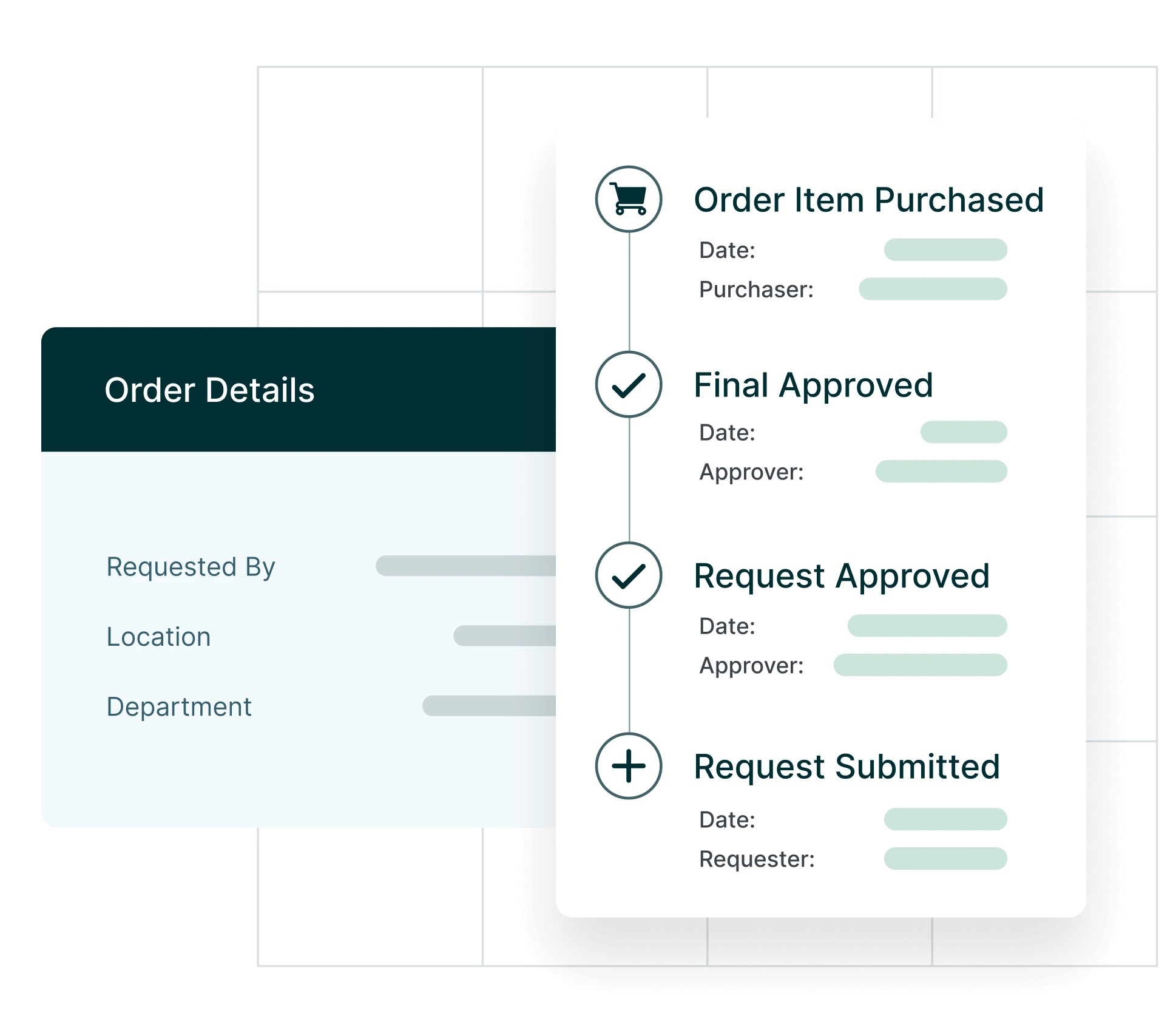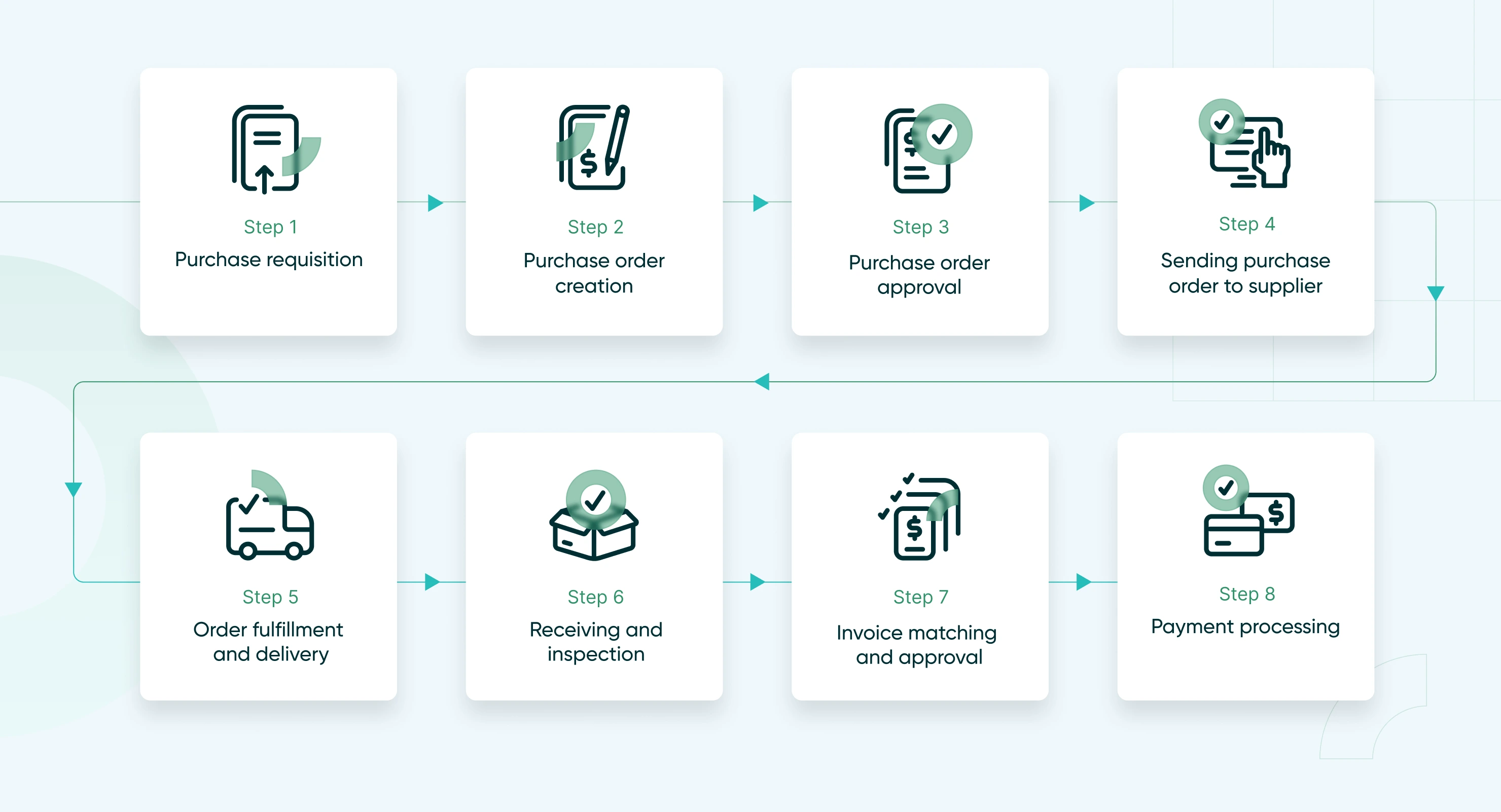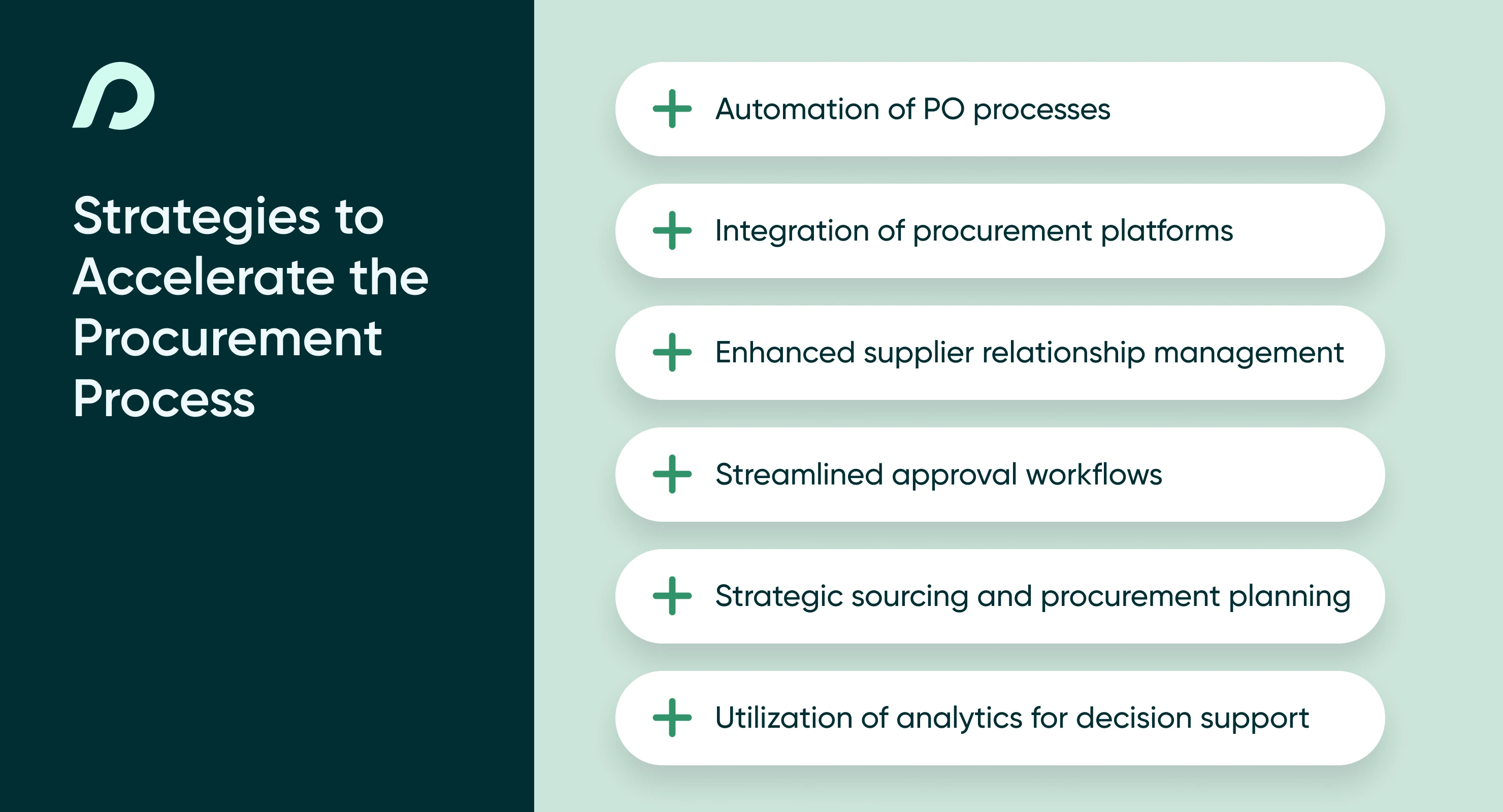
How to Manage Purchase Orders Efficiently: Modern Strategies for Faster Procurement
In procurement, speed means little without control. Managing purchase orders efficiently isn’t just about processing requests faster — it’s about ensuring every dollar spent is tracked, approved, and aligned with company goals.
Modern purchase order management has evolved far beyond spreadsheets and email chains. Automation and AI now handle much of the repetitive work like routing purchases with approval workflows, matching invoices, and surfacing spend insights in near real time.
The result? Finance and operations teams can move quickly and maintain complete visibility over commitments.
Whether you’re managing a few dozen POs a month or thousands across multiple locations, efficient purchase order management keeps procurement organized, auditable, and scalable.
In this article, we’ll break down the challenges that slow purchasing teams down and discuss how automation and AI can transform a reactive process into a proactive system that saves time, strengthens supplier relationships financial control.

Ready to Automate Your Purchasing Process?
Procurify’s procure-to-pay software automates your company’s purchasing workflow from order creation and approvals to invoice payment – to speed up purchasing, improve internal communication, and minimize financial risk.
Understanding purchase order management
Purchase order management sits at the core of an efficient procurement strategy. This is necessary to ensure the purchase order process follows a clear, traceable path that balances speed with control, from the first request to final payment.
At its simplest, purchase order management is the process of creating, tracking, and closing purchase orders (POs). A PO acts as a formal agreement between a buyer and supplier, outlining exactly what’s being purchased, at what cost, and under what terms. Once approved, it becomes a legally binding document that anchors financial accountability, audit readiness, and supplier trust.
It is important to know that the purpose of purchase orders still matters today. In a modern world, efficient PO management extends far beyond paperwork. Modern AI powered procure to pay solutions connect approvals, suppliers, and payments in a single digital workflow giving teams real-time visibility into spending and commitments helping them manage their spend like never before.
Understanding the purchase order management process

-
Purchase requisition: The process starts with a purchase requisition made internally within a company, specifying the need for goods or services.
-
Approval and PO creation: Automated workflows route the request to approvers based on spend thresholds or departments. Once approved, it converts to a formal purchase order.
-
PO dispatch: The purchase order is sent electronically to the supplier for confirmation.
-
Order confirmation and fulfillment: The supplier delivers the goods or services as agreed.
-
Receipt and verification: The buyer confirms that the delivery matches order details and quality standards
-
Invoice matching and payment: With three way matching, the invoice is automatically matched to the PO and receipt before payment is processed.
-
Record keeping and closure: After payment, the transaction is recorded and closed out in the system delivering a complete audit trail and data for spend analysis.
Why efficient purchasing management matters
When managed well, purchase orders do far more than track transactions. They:
-
Improve financial control by linking every purchase to a budget or project
-
Increase operational efficiency by reducing manual work and errors.
-
Compliance and record-keeping ensure compliance with company policies and provide audit trails.
-
Strengthen supplier relationships through improved communication and negotiations, resulting in better pricing and more favorable terms.
An efficient purchase order process isn’t just about speed — it’s about visibility, predictability, and smarter decision-making.
Common challenges in PO management
Regardless of size, how companies manage orders tends to be one of the most time-consuming and error-prone aspects of the purchasing cycle. Many teams still face inefficiencies that slow approvals, create visibility gaps, and strain supplier relationships. Recognizing these challenges is the first step toward building a faster, smarter, and more connected procurement process.
-
Manual processes and paperwork
Many organizations still rely on spreadsheets or paper-based systems to manage purchase orders. These manual processes slow down purchasing, increase data-entry errors, and make it difficult to enforce approval rules or monitor real-time spend. Inaccuracies in quantities, prices, or supplier details often lead to delays, rework, and budget discrepancies.
-
Inefficient approval workflows
Lengthy or unclear approval chains can bring the entire procurement process to a halt. When approvers are unavailable or when rules aren’t automated, requests linger in inboxes, creating bottlenecks that delay purchasing and disrupt operations
-
Lack of integration across systems
When purchasing software isn’t connected to accounting, inventory, or ERP systems, teams lose visibility into order status and financial commitments. Disconnected data leads to duplicated work, inconsistent records, and difficulty reconciling POs, invoices, and receipts.
-
Poor supplier communication
Communication breakdowns between buyers and suppliers can cause missed deliveries or mismatched orders. Without shared visibility into PO status and fulfillment, procurement teams spend valuable time following up manually instead of managing performance or strategic sourcing.
-
Limited data tracking and analysis
Without centralized, analyzable purchase order data, finance and procurement leaders can’t easily identify trends or spot risks. Limited reporting prevents teams from forecasting accurately, evaluating supplier performance, or uncovering cost-saving opportunities.
In short: most purchase order challenges come down to manual work, disconnected systems, and lack of visibility.
The next step is moving from reaction to automation — where approvals route automatically, supplier updates sync in real time, and spend data becomes actionable.
How to make purchase order management easier
Here’s how modern procurement teams are improving the speed and accuracy of every purchase order:
-
1. Start with visibility, not speed
Before automating anything, ensure that every purchase order is visible — including who requested it, where it’s stuck, and which budget it is tied to. You can’t accelerate what you can’t see. Centralized PO dashboards or approval logs immediately uncover hidden bottlenecks.
-
2. Automate where it matters most
Automation doesn’t need to mean overhauling everything. Focus on the repetitive, time-consuming steps that deliver the biggest impact — like automatic routing for low-risk purchases or three-way invoice matching. You’ll save hours weekly and reduce approval fatigue across teams.
-
Connect systems so data flows, not files
Disconnected platforms are the silent killers of procurement speed. Integrating your PO management tool with accounting, inventory, and ERP systems means you can skip reconciliation headaches and track commitments in real time. When finance and procurement share the same data, month-end closes become simpler — not stressful.
-
4. Use suppliers as partners, not checkpoints
Fast procurement doesn’t come from internal efficiency alone. Building predictable workflows with your top suppliers — shared order visibility, auto-confirmations, and clear SLAs — cuts days off turnaround times. Collaboration is often a faster fix than another automation layer.
-
5. Measure, iterate, repeat
Modern PO management is never “done.” Use analytics to track approval times, identify slow points, and refine your workflow monthly. The fastest teams aren’t the ones that automate everything — they’re the ones that keep improving intelligently
When your purchase order process becomes visible, connected, and continuously improving, “faster” is just the starting point — it becomes effortless.
How to speed up procurement operations

Once your purchase order process is standardized and digitized, the next step is scale. Acceleration isn’t just about doing the same work faster — it’s about creating a connected procurement system that moves intelligently from request to reconciliation.
Here’s how organizations are scaling their procurement processes to gain both speed and strategic control.
Automate for precision, not just speed
Modern automation tools don’t just replace manual tasks — they improve accuracy and accountability. Systems that auto-route approvals, pre-validate budget codes, and automatically match invoices to POs can eliminate up to 60% of manual intervention. The result: faster cycle times and fewer downstream corrections.
Pro tip: Start by automating high-volume, low-risk purchases — like office supplies or recurring vendor spend — where speed brings the most impact.
Connect your platforms for a single source of truth
Procurement shouldn’t live in a silo. PO management software should be integrated throughout your systems including, ERPs, AP, and inventory systems to ensure every stakeholder has access to the same data in real time. That means finance sees spend commitments before invoices arrive, operations can forecast inventory more accurately, and procurement gains end-to-end visibility across the purchasing cycle.
Treat supplier relationships as partnerships
The fastest procurement teams treat suppliers like partners, not checkpoints. Establish shared visibility through vendor portals, automated confirmations, and delivery updates to reduce back-and-forth emails. When both sides are aligned on timelines and expectations, purchase order turnaround improves dramatically.
Tip: Evaluate suppliers based not only on price but also on their digital readiness — responsive vendors shorten your entire procurement cycle.
Simplify approvals with smart routing
Instead of routing every PO through the same chain of command, use tiered approval logic. For example, under-$5,000 requests might auto-approve within a department, while higher-value purchases route to finance. Smart workflows keep governance intact without slowing your team down.
Use analytics to drive proactive decisions
Speed doesn’t matter if you’re flying blind. Analytics turn your purchase order data into foresight — helping identify which departments are most prone to delays, which vendors miss SLAs, and where budget overruns begin. With this insight, procurement leaders can anticipate problems before they cause friction.
Plan strategically to reduce last-minute spending
Rushed purchases are the biggest enemy of efficiency, making non purchase orders a thing of the past. Regularly reviewing procurement data helps teams anticipate recurring needs and consolidate supplier contracts. Strategic sourcing reduces rush orders, premium shipping fees, and emergency purchases that disrupt workflows.
What to look for in purchasing management software
Here’s what to look for when choosing a platform that fits your organization:
-
Easily integrates with existing systems and processes
Choose a system that should connect effortlessly with the systems you already use — whether that’s your ERP, accounting software, or inventory management platform. When data flows automatically between these tools, you eliminate duplicate entries, improve reporting accuracy, and make approvals faster.
Pro tip: Ask vendors to show real examples of how their integrations work in practice, not just on paper.
-
Modular and can scale as your business grows
What works for a 50-person company often breaks at 500. Choose software that can scale with your organization — adding new departments, users, and approval layers without slowing performance or overcomplicating the process.
-
Easy for everyone to use
Procurement tools only deliver value when people actually use them. Look for intuitive dashboards, clear approval routing, and mobile-friendly access. The simpler the interface, the faster your team will adopt it — and the less time you’ll spend on training or troubleshooting.
-
Customizable to your workflows
Every organization’s purchasing process looks a little different. The right platform should adapt to your approval policies, budget codes, and vendor categories — not force you into rigid templates.
-
Reliable support and onboarding
A smooth rollout depends on responsive support and thorough onboarding. Choose vendors who invest in your success with hands-on setup, live chat, and ongoing optimization — not just a ticketing system.
-
Strong security and compliance
Purchase order data touches budgets, vendor banking details, and internal approvals — which means it needs enterprise-grade protection. Make sure your platform provides encryption, permission-based access, and compliance with finance or industry standards.
When the right systems work quietly in the background, purchasing runs exactly as it should: fast, transparent, and free of friction.
Next step: Take a quick Product Tour and see how it can work for you.
FAQs

2025 Procurement Benchmark Report
Powered by $20B+ in proprietary data you won’t find anywhere else.
